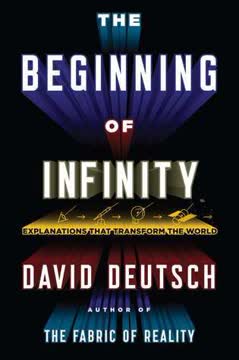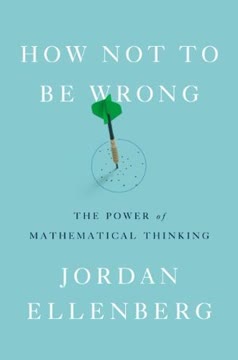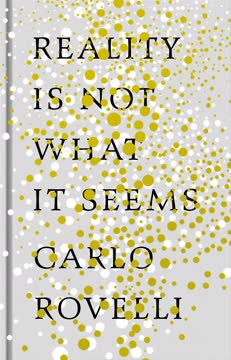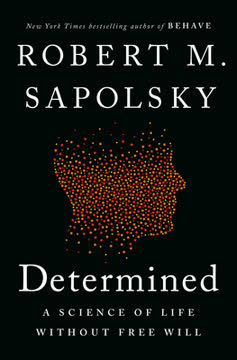Key Takeaways
1. Symmetry is a universal language that shapes nature, art, and science
"Symmetry is the language of nature, and mathematics is the key to unlocking its secrets."
Nature's symmetry. From snowflakes to seashells, symmetry is pervasive in the natural world. It's not just about aesthetics; symmetry often indicates genetic superiority, efficient energy use, and evolutionary fitness. For example:
- Flowers use symmetrical patterns to attract pollinators
- Animals with more symmetrical features are often perceived as healthier mates
- Crystals and molecules organize themselves into symmetrical structures to minimize energy
Art and architecture. Humans have long been drawn to symmetry in their creations:
- Ancient structures like Stonehenge and the pyramids exhibit careful symmetrical planning
- Islamic art and architecture, as seen in the Alhambra, explore complex symmetrical patterns
- Modern artists and architects continue to play with symmetry, from M.C. Escher's mind-bending works to the geodesic domes of Buckminster Fuller
Scientific applications. Symmetry has become a powerful tool across scientific disciplines:
- In physics, symmetry principles underlie fundamental laws of nature
- Chemistry uses symmetry to understand molecular structures and reactions
- Biology employs symmetry in studying everything from DNA to ecosystems
2. Mathematical breakthroughs often arise from unexpected connections
"The knowledge which mathematicians now possess of the structure of algebraic forms is as different from what it was before Cayley's time as the knowledge of the human body possessed by one who has dissected it and knows its internal structure is different from that of one who had only seen it from the outside."
Serendipitous discoveries. Many mathematical advances come from seemingly unrelated areas colliding:
- The study of equations led to new insights about geometric shapes
- Number theory problems inspired developments in cryptography
- Group theory, developed for abstract algebra, found applications in particle physics
Cross-pollination of ideas. Mathematicians often make progress by:
- Applying techniques from one field to problems in another
- Recognizing patterns across different areas of mathematics
- Collaborating with researchers from diverse backgrounds
The power of abstraction. By stripping away specifics and focusing on underlying structures, mathematicians can:
- Reveal hidden connections between disparate concepts
- Develop more general and powerful theories
- Create new mathematical tools with wide-ranging applications
3. The study of symmetry revolutionized our understanding of equations
"Galois realized that there was a subtler question underlying the attempt to solve the quintic. Tartaglia had found ways to twist the cubic until it looked just like an equation that involved taking cube roots and square roots. Although Abel had proved that in general this was impossible to do for all quintics, there were still some equations such as x5 =3 that could be solved using fifth roots. But what about something like x5 +6x +3=0?"
The quintic equation puzzle. For centuries, mathematicians struggled to find a general formula for solving fifth-degree (quintic) equations, similar to the quadratic formula. The breakthrough came from a new perspective:
- Évariste Galois introduced the concept of symmetry groups associated with equations
- He showed that the solvability of an equation depends on the structure of its symmetry group
- This explained why some quintics could be solved while others couldn't
Group theory emerges. Galois' work laid the foundation for a new branch of mathematics:
- Groups formalized the concept of symmetry in abstract terms
- This allowed for the classification of symmetries in diverse contexts
- Group theory became a powerful tool across mathematics and physics
Beyond equations. The symmetry approach revolutionized other areas:
- It provided new ways to understand geometric shapes and their properties
- It offered insights into the structure of matter and fundamental particles
- It became a unifying concept across diverse mathematical fields
4. Symmetry groups provide a powerful framework for classifying patterns
"There are only 17 different types of tiling symmetry. Any pattern that is repeated both vertically and horizontally must fit into one of these 17 classes."
Wallpaper groups. The 17 symmetry groups classify all possible repeating patterns in two dimensions:
- This includes reflections, rotations, translations, and glide reflections
- Examples range from simple grids to complex interlocking designs
- These groups were discovered independently by mathematicians and artisans
Three-dimensional symmetries. The classification extends to 3D space:
- There are 230 crystallographic groups describing possible crystal structures
- This has important applications in materials science and chemistry
Abstract classifications. The power of group theory allows for broader categorizations:
- Simple groups: the "building blocks" of all other groups
- Finite groups: groups with a limited number of elements
- Lie groups: continuous symmetry groups important in physics
Applications. These classifications have practical uses:
- In crystallography for analyzing and predicting material properties
- In chemistry for understanding molecular structures
- In physics for describing fundamental particles and their interactions
5. Viruses exploit symmetry for efficient replication and survival
"What Crick recognized was that the small length of the program contained inside a virus meant that a new structure would necessarily have to be built in a very simple manner. And this is the power of symmetry."
Viral architecture. Many viruses have highly symmetrical structures:
- Icosahedral (20-sided) shapes are common, as seen in the polio virus
- Helical structures, like in the tobacco mosaic virus, are another symmetrical form
- These shapes allow for efficient packing of genetic material
Genetic economy. Symmetry allows viruses to encode complex structures with minimal genetic information:
- A small set of instructions can be repeated to build a large, complex shell
- This is crucial given the limited size of viral genomes
Self-assembly. Symmetrical structures facilitate spontaneous formation:
- Protein subunits can come together without external guidance
- This process is driven by energetic favorability of symmetrical arrangements
Evolutionary advantage. Symmetry in viruses provides:
- Structural stability to protect genetic material
- Efficient use of limited resources
- Ability to adapt to different host environments
6. The human brain is hard-wired to seek and appreciate symmetry
"Evolution has programmed us to be oversensitive to symmetry. Those that can spot a pattern with reflectional symmetry in the chaotic tangle of the jungle are more likely to survive."
Evolutionary advantage. Our brains are tuned to notice symmetry because:
- It often indicates potential threats or food sources in nature
- Symmetrical features in potential mates suggest genetic fitness
- Recognizing patterns and regularities aids in learning and prediction
Psychological impact. Symmetry affects our perceptions and emotions:
- Symmetrical faces are generally perceived as more attractive
- Symmetrical designs often evoke feelings of order and calm
- Asymmetry can create tension or draw attention
Cognitive processes. Symmetry plays a role in how we think:
- It aids in memory and pattern recognition
- It influences our aesthetic judgments
- It shapes our intuitive understanding of mathematics and logic
Cultural expressions. Our fascination with symmetry is reflected in:
- Art and architecture across cultures and time periods
- Religious and spiritual symbols (e.g., mandalas)
- Scientific and mathematical pursuits
7. Symmetry plays a crucial role in modern communication and error correction
"With so much electronic fluctuation and strong magnetic fields interfering with the digital data, whether travelling through the atmosphere, along cables or through the vacuum of space, scientists have been forced to come up with ways to tell whether data has been corrupted."
Error detection and correction. Symmetry-based codes allow for:
- Identifying when errors have occurred in data transmission
- Reconstructing the original message even with some corrupted data
- Efficient use of bandwidth by minimizing redundancy
Digital storage. Symmetrical coding schemes improve data reliability:
- CDs and DVDs use error-correcting codes to compensate for scratches and defects
- Hard drives employ similar techniques to ensure data integrity
Telecommunications. Symmetry underlies many communication protocols:
- Mobile phone networks use error-correcting codes for clear transmissions
- Satellite communications rely on these techniques for long-distance data transfer
Quantum computing. Emerging technologies leverage symmetry for:
- Creating stable quantum states for information processing
- Developing error-correction schemes for quantum systems
Broader impacts. Symmetry-based coding has enabled:
- More reliable and efficient digital communications
- Increased data storage capacities
- Advancements in fields like space exploration and medical imaging
Last updated:
FAQ
What is Symmetry: A Journey into the Patterns of Nature by Marcus du Sautoy about?
- Exploration of symmetry: The book is a journey through the concept of symmetry, tracing its presence in nature, mathematics, art, and science, and revealing how patterns shape our understanding of the world.
- Personal and historical narrative: Marcus du Sautoy weaves his own experiences with the stories of key mathematicians, connecting abstract mathematical ideas to tangible natural and cultural phenomena.
- Interdisciplinary connections: The narrative links symmetry to biology, art, architecture, music, and even psychology, showing its pervasive influence across disciplines.
Why should I read Symmetry: A Journey into the Patterns of Nature by Marcus du Sautoy?
- Accessible insight into mathematics: The book presents advanced concepts like group theory and symmetry in an engaging, understandable way, making them accessible to readers without a deep math background.
- Historical and cultural richness: It offers a rich context, connecting mathematics to human culture, history, and creativity, from ancient civilizations to modern discoveries.
- Inspiration and relevance: Readers gain an appreciation for how symmetry underlies natural phenomena, art, and technology, and are inspired by the personal stories of mathematicians.
What are the key takeaways from Symmetry: A Journey into the Patterns of Nature by Marcus du Sautoy?
- Symmetry as a universal language: Symmetry is a fundamental language that underpins the universe, connecting mathematics, nature, and human creativity.
- Group theory’s central role: The book highlights group theory as the mathematical framework for understanding and classifying symmetry.
- Interconnectedness of disciplines: Symmetry links diverse fields such as biology, art, music, physics, and information theory, revealing hidden patterns and structures.
- Human quest for understanding: The narrative emphasizes the historical and ongoing human effort to decode the patterns of nature through mathematics.
What are the most memorable quotes from Symmetry: A Journey into the Patterns of Nature by Marcus du Sautoy and what do they mean?
- On mathematical immortality: G. H. Hardy’s quote, “Archimedes will be remembered when Aeschylus is forgotten...,” highlights the enduring nature of mathematical ideas beyond language and culture.
- On mathematicians’ fate: Sophie Germain’s reflection on the “fate or spell hovering over everything that has to do with mathematics” underscores the challenges and tragedies often faced by great mathematicians.
- On the purpose of symmetry: Mao Tse-Tung’s question, “Of what use is symmetry?” prompts readers to consider the practical and philosophical significance of symmetry, which the book explores in depth.
How does Marcus du Sautoy explain the concept of symmetry in nature in Symmetry: A Journey into the Patterns of Nature?
- Symmetry as communication: The book describes symmetry as a language used by plants and animals to convey messages about genetic fitness, nutrition, and survival.
- Efficiency and stability: Symmetry is linked to natural efficiency, such as the hexagonal honeycomb minimizing material use, and to physical stability, like soap bubbles forming spheres.
- Attraction and selection: Humans and animals are genetically programmed to prefer symmetrical mates, associating symmetry with health and evolutionary fitness.
What is group theory and why is it important in Symmetry: A Journey into the Patterns of Nature by Marcus du Sautoy?
- Mathematical language of symmetry: Group theory is presented as the framework that captures the essence of symmetry, describing all possible symmetry operations that leave an object unchanged.
- Classification and distinction: It explains how group theory distinguishes between different types of symmetries and underpins the classification of symmetrical objects.
- Foundation for modern mathematics: Group theory is central to understanding patterns in mathematics, physics, chemistry, and beyond, serving as a unifying principle throughout the book.
How does Symmetry: A Journey into the Patterns of Nature by Marcus du Sautoy connect the history of solving equations to symmetry?
- From algebra to symmetry: The book traces the evolution from solving polynomial equations to realizing that their solvability is linked to the symmetry of their roots.
- Galois theory’s breakthrough: Évariste Galois’s insight connected the structure of symmetry groups to the possibility of solving equations by radicals.
- Mathematical revolution: This connection led to the understanding that certain equations, like the quintic, cannot be solved by general formulas due to the complexity of their symmetry groups.
Who was Évariste Galois and what was his contribution to symmetry, according to Marcus du Sautoy?
- Revolutionary mathematician: Galois was a young French mathematician who founded group theory and revolutionized the understanding of symmetry in equations.
- Group concept and simplicity: He introduced the idea of studying all symmetries of an object as a group and discovered the concept of simple (indivisible) groups.
- Enduring legacy: Despite a short and tragic life, Galois’s ideas underpin much of modern algebra and symmetry theory, as highlighted in the book.
What are finite simple groups and sporadic groups, and how are they explained in Symmetry: A Journey into the Patterns of Nature by Marcus du Sautoy?
- Building blocks of symmetry: Finite simple groups are the fundamental building blocks for all finite groups, classified into cyclic, alternating, Lie type, and 26 sporadic groups.
- Sporadic groups’ uniqueness: The sporadic groups, including the Monster group, are exceptional and do not fit into infinite families, making them rare and intriguing.
- Historical achievement: The classification of finite simple groups is a monumental mathematical achievement, involving decades of collaborative work and thousands of pages of proof.
What is the Monster group and what is Monstrous Moonshine, as described in Symmetry: A Journey into the Patterns of Nature by Marcus du Sautoy?
- Largest sporadic simple group: The Monster group is an enormous mathematical object with about 8×10^53 symmetries, existing in a 196,883-dimensional space.
- Moonshine connection: Monstrous Moonshine refers to the mysterious link between the Monster group and modular functions from number theory, discovered through numerical coincidences.
- Mathematical and physical impact: This connection has deep implications for algebra, number theory, and string theory, and its proof by Borcherds earned a Fields Medal.
How does Marcus du Sautoy relate symmetry to art, music, and culture in Symmetry: A Journey into the Patterns of Nature?
- Music and mathematics: The book explores how composers like Bach and Schoenberg used symmetry in musical structures, and how group theory explains these patterns.
- Art and architecture: Islamic art, especially the Alhambra’s tilings, is discussed as a manifestation of mathematical symmetry groups, with patterns corresponding to the 17 wallpaper groups.
- Cognitive and emotional resonance: Symmetry’s role in human perception, memory, and creativity is examined, highlighting its universal appeal and cultural significance.
What is the significance of the 17 wallpaper groups in Symmetry: A Journey into the Patterns of Nature by Marcus du Sautoy?
- Complete classification: The 17 wallpaper groups represent all possible two-dimensional repeating symmetry patterns, involving translations, rotations, reflections, and glide reflections.
- Historical and artistic context: The book highlights their appearance in Moorish art, especially in the Alhambra, as a pinnacle of artistic and mathematical achievement.
- Foundation for modern theory: Understanding these groups is foundational for crystallography, art, and modern symmetry theory, showing how ancient art anticipated deep mathematical truths.
Review Summary
Symmetry receives mostly positive reviews, with readers praising du Sautoy's ability to explain complex mathematical concepts in an accessible way. Many appreciate the blend of mathematical history, personal anecdotes, and explanations of symmetry in nature. Some criticize the book's structure and occasional repetitiveness. Readers with mathematical backgrounds tend to enjoy it more, while those seeking a basic introduction to symmetry may find parts challenging. Overall, it's viewed as an engaging exploration of symmetry's role in mathematics and the natural world.
Similar Books







Download PDF
Download EPUB
.epub digital book format is ideal for reading ebooks on phones, tablets, and e-readers.






